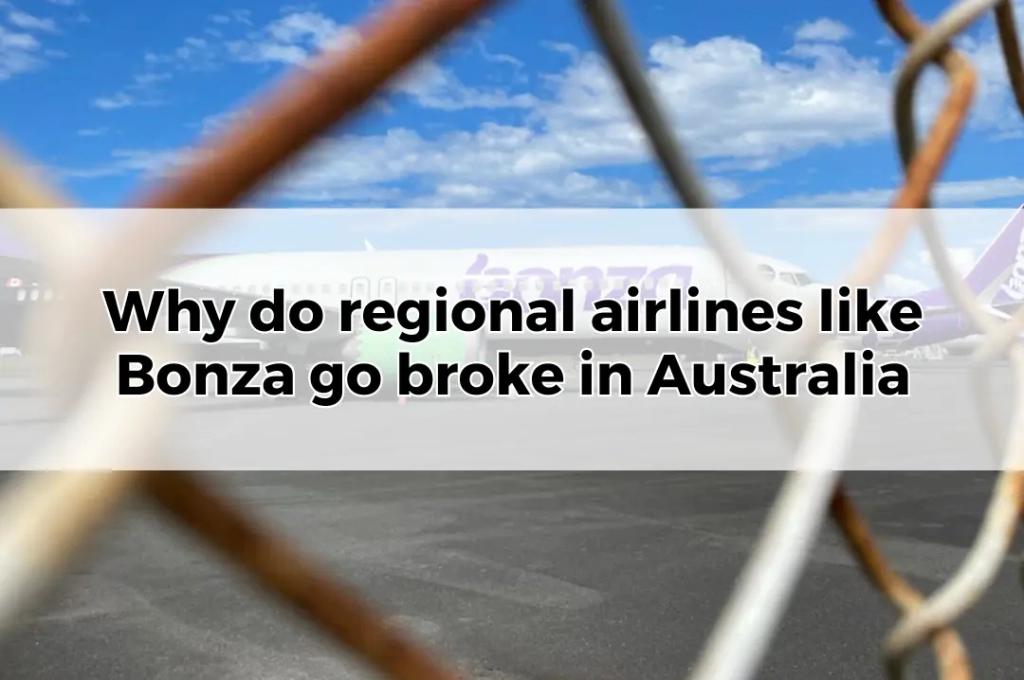Why do regional airlines like Bonza go broke in Australia
Table of Contents
ToggleThe Dynamics of Australia's Airline Industry
Overview of Australia's Regional Airline Market
Australia’s aviation industry is a dynamic ecosystem, encompassing both national and regional airlines. The market’s growth has been marked by rapid evolution, including new entrants, mergers, and, unfortunately, numerous failures. These shifts reflect the complexity of the industry’s financial landscape, which has seen many players come and go.
The Rise and Fall of Notable Airlines
The Australian airline industry has witnessed the rise and fall of several airlines. Notably, Ansett Airlines once soared high, only to crash into financial ruin. Likewise, Bonza’s recent emergence as a newcomer has been fraught with challenges, highlighting the volatile nature of the market and its numerous financial pitfalls.
Economic Factors in the Demise of Australian Airlines
Operating Costs and the Price War
Running an airline in Australia involves significant financial burdens. Fuel costs, staff salaries, and aircraft maintenance are considerable drains on even the most established airlines. Compounding these costs, a price war among competitors further squeezes margins, leading to financial instability.
Market Saturation and Competition
The airline industry in Australia is saturated, particularly on popular routes. This oversaturation intensifies competition, driving down ticket prices and limiting profitability, especially for regional airlines with fewer resources to weather financial turbulence.
Financial Impacts of the COVID-19 Pandemic
The COVID-19 pandemic delivered a crushing blow to the airline industry. Grounded flights, travel restrictions, and plummeting passenger numbers resulted in massive revenue losses. This financial devastation led to the downfall of many airlines and continues to impact the industry’s recovery.
Regulatory Hurdles and Governmental Intervention
Civil Aviation Safety Authority (CASA) Regulations
Australia’s Civil Aviation Safety Authority (CASA) enforces stringent regulations aimed at ensuring passenger safety. While necessary, these regulations impose additional costs on airlines, particularly regional carriers with limited financial resources.
Government Bailouts and Support
Governmental intervention has occasionally provided a lifeline for struggling airlines. However, these bailouts have often proven insufficient, failing to prevent the eventual demise of several airlines, including Ansett. This highlights the limited efficacy of such measures.
Geographical Challenges: The Tyranny of Distance
Route Economics and Viability
Australia’s vastness presents unique challenges for its airlines. The tyranny of distance between cities and regional hubs necessitates careful route planning. However, thinly traveled routes can render some airlines unprofitable, especially when serving remote destinations.
Impact of Remote Destinations on Airline Profitability
Serving Australia’s remote destinations, while essential, can be a financial drain. The sparse populations and limited demand make it challenging to fill flights, reducing profitability and creating an unsustainable business model for many regional carriers.
Management and Strategic Missteps
Leadership Blunders and Strategic Failures
Leadership decisions play a crucial role in an airline’s success or failure. Misguided expansions, ill-fated partnerships, and an inability to adapt to changing market conditions have led to the collapse of several Australian airlines, including Ansett.
Failure to Adapt to Market Trends
The airline industry is ever-evolving, and failure to adapt can be fatal. Many defunct airlines were unable to keep pace with changing consumer preferences and industry innovations, leading to a steady decline in business.
Customer Preferences and Trends
Changing Travel Habits
Consumer preferences have shifted over time, with more travelers opting for low-cost carriers. This shift has reshaped the industry, creating new opportunities and challenges for airlines trying to navigate a changing market.
Loyalty Programs and Brand Perception
Loyalty programs have emerged as a key differentiator, yet many regional airlines have struggled to cultivate strong brand identities. This failure to establish meaningful customer loyalty has contributed to their demise.
Technological Disruptions and Innovations
Impact of Technological Advancements on the Industry
Technological advancements have revolutionised the airline industry, from booking systems to in-flight services. However, for many regional airlines, adapting to these changes has proven difficult, leaving them at a disadvantage.
The Role of Digital Platforms in Airline Viability
Digital platforms, including online booking and comparison tools, have transformed the way travelers choose airlines. This shift has intensified competition, making it harder for smaller airlines to maintain a foothold in the market.
Case Studies: Bonza, Ansett, and Beyond
Ansett Airlines: A Tale of Misfortune
Ansett’s collapse serves as a stark reminder of the industry’s volatility. Mismanagement, financial strain, and an inability to adapt to changing market conditions led to its eventual downfall, despite its early successes.
Bonza: Newcomer Challenges and Future Prospects
Bonza, a more recent entrant to the market, has faced numerous hurdles, including regulatory challenges and market saturation. Its future remains uncertain, reflecting the precarious nature of the Australian airline industry.
Attractiveness of the Australian Airline Industry to Investors
Return on Investment and Profit Margins
The airline industry’s thin profit margins and high operational costs make it a challenging investment. Regional airlines, in particular, struggle to provide compelling returns, deterring many potential investors.
Investor Hesitance and the Industry’s Reputation
The industry’s reputation for volatility has made investors wary. High-profile collapses, like Ansett’s, have reinforced the perception that Australian airlines are a risky bet, further diminishing investment prospects.
Conclusion: The Future of Regional Airlines in Australia
Lessons Learned from Defunct Airlines
The rise and fall of numerous Australian airlines offer valuable lessons. Strategic adaptability, efficient management, and sustainable business models are essential for survival in this challenging industry.
Sustainable Strategies for Newcomers
Newcomers must heed these lessons and focus on sustainable strategies. By balancing profitability, adaptability, and customer satisfaction, they can navigate the turbulent skies of the Australian airline industry, avoiding the pitfalls of their predecessors.









